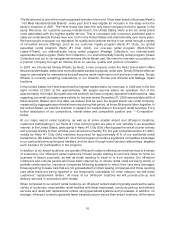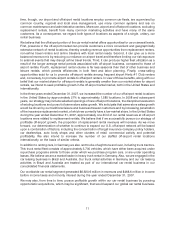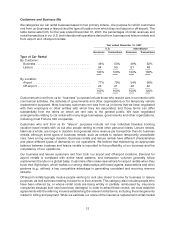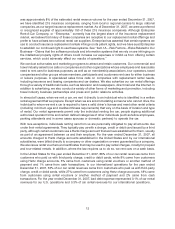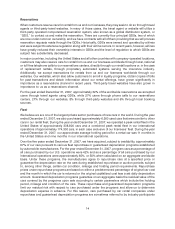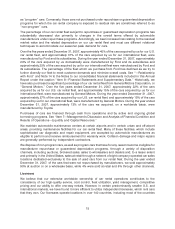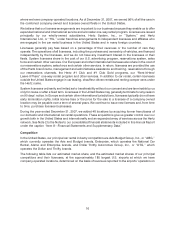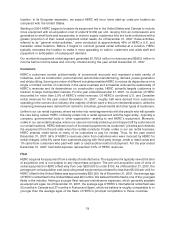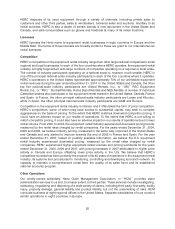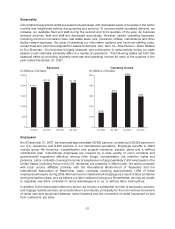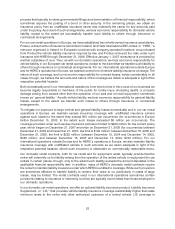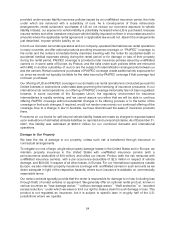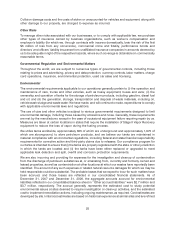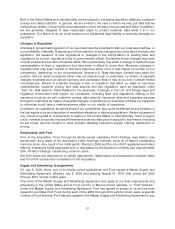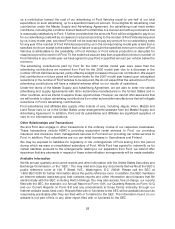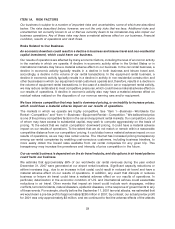Hertz 2007 Annual Report Download - page 39
Download and view the complete annual report
Please find page 39 of the 2007 Hertz annual report below. You can navigate through the pages in the report by either clicking on the pages listed below, or by using the keyword search tool below to find specific information within the annual report.location. In its European expansion, we expect HERC will incur lower start-up costs per location as
compared with the United States.
Starting in 2004, HERC began to broaden its equipment line in the United States and Canada to include
more equipment with an acquisition cost of under $10,000 per unit, ranging from air compressors and
generators to small tools and accessories, in order to supply customers who are local contractors with a
greater proportion of their overall equipment rental needs. As of December 31, 2007, these activities,
referred to as ‘‘general rental activities,’’ were conducted at approximately 49% of HERC’s U.S. and
Canadian rental locations. Before it begins to conduct general rental activities at a location, HERC
typically renovates the location to make it more appealing to walk-in customers and adds staff and
equipment in anticipation of subsequent demand.
Our worldwide equipment rental segment generated $1,755.9 million in revenues and $308.5 million in
income before income taxes and minority interest during the year ended December 31, 2007.
Customers
HERC’s customers consist predominantly of commercial accounts and represent a wide variety of
industries, such as construction, petrochemical, automobile manufacturing, railroad, power generation
and shipbuilding. Serving a number of different industries enables HERC to reduce its dependence on a
single or limited number of customers in the same business and somewhat reduces the seasonality of
HERC’s revenues and its dependence on construction cycles. HERC primarily targets customers in
medium to large metropolitan markets. For the year ended December 31, 2007, no customer of HERC
accounted for more than 2.0% of HERC’s rental revenues. Of HERC’s combined U.S. and Canadian
rental revenues for the year ended December 31, 2007, roughly half were derived from customers
operating in the construction industry (the majority of which were in the non-residential sector), while the
remaining revenues were derived from rentals to industrial, governmental and other types of customers.
Unlike in our car rental business, where we enter into rental agreements with the people who will operate
the cars being rented, HERC ordinarily enters into a rental agreement with the legal entity—typically a
company, governmental body or other organization—seeking to rent HERC’s equipment. Moreover,
unlike in our car rental business, where our cars are normally picked up and dropped off by customers at
our rental locations, HERC delivers much of its rental equipment to its customers’ job sites and retrieves
the equipment from the job sites when the rentals conclude. Finally, unlike in our car rental business,
HERC extends credit terms to many of its customers to pay for rentals. Thus, for the year ended
December 31, 2007, 94% of HERC’s revenues came from customers who were invoiced by HERC for
rental charges, while 5% came from customers paying with third-party charge, credit or debit cards and
1% came from customers who paid with cash or used another method of payment. For the year ended
December 31, 2007, bad debt expense represented 0.3% of HERC revenues.
Fleet
HERC acquires its equipment from a variety of manufacturers. The equipment is typically new at the time
of acquisition and is not subject to any repurchase program. The per-unit acquisition cost of units of
rental equipment in HERC’s fleet vary from over $200,000 to under $100. As of December 31, 2007, the
average per-unit acquisition cost (excluding small equipment purchased for less than $5,000 per unit) for
HERC’s fleet in the United States was approximately $35,000. As of December 31, 2007, the average age
of HERC’s rental fleet in the United States was 29 months. We believe that this fleet is one of the youngest
fleets in the industry. Having a younger fleet reduces maintenance expenses, which generally escalate
as equipment ages. As of December 31, 2007, the average age of HERC’s international rental fleet was
30 months in Canada and 27 months in France and Spain, which we believe is roughly comparable to or
younger than the average ages of the fleets of HERC’s principal competitors in those countries.
19



